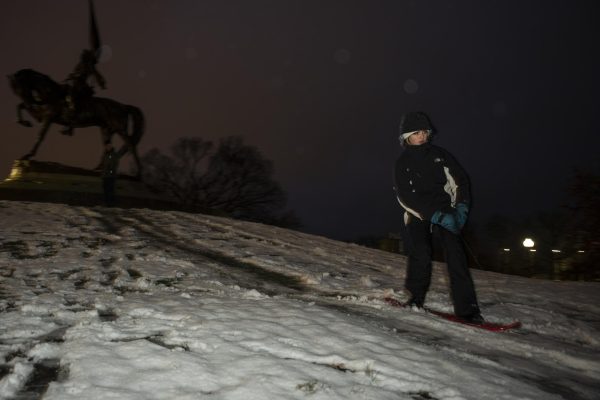Breaking down Columbia’s new standardized flat fee amid tuition hike — what it means for students
March 1, 2022

As the Spring 2022 midterms approach, this semester is the last time students will pay Columbia’s mandatory fees separately, as they will be rolled into one standardized flat fee of $1,450 per year beginning in Fall 2022.
With the announcement of a 10% hike in tuition and 2.5% increase in the cost of living in residence halls for next year, the Chronicle analyzed the new fee structure to determine how it would impact students, specifically breaking down the numbers to determine if students would also be paying more in fees.
The Chronicle obtained data from 10 students in 10 different majors at various points in their academic careers to get a snapshot of what Columbia students are currently paying in fees.
Of the 10 people who shared their fee data, including instructional fees, which vary student to student, five would actually pay less in fees under the flat, standardized fee structure next year. The other five would pay more, in addition to the 10% tuition hike, which will cost full-time students $2,660 more per year.
The new $1,450 fee will replace the current separate and fluctuating fees for undergraduate students. Items that will be included in this standardized flat fee are a $300 student activity fee, $170 Student Health Center fee, $300 technology fee, $100 registration fee and about $580 in instructional fees, according to an infographic shared with the Chronicle. Under the current structure, new students also pay a one-time $125 orientation fee, and there is a one-time graduation fee of $175.
The new fee structure was announced in tandem with President and CEO Kwang-Wu Kim’s collegewide email on Nov. 16, informing students of the 10% tuition increase for undergraduate students in the Fall 2022-23 academic year.
The standardized flat fee will also apply to part-time students, who will pay a standardized annual flat fee of $870.
Jerry Tarrer, senior vice president of Business Affairs and Columbia’s chief financial officer, said the standardized flat fee is not an additional fee for Columbia students — rather it is a combination of existing fees for which students would pay $1,450 per year on average, wrapped into one payment.
“This year, … [the college] said, ‘Okay, instead of having a student pay all those individual fees, let’s roll them together and charge one fee of $1,450,’” Tarrer said.
Tarrer said the annual instruction fees cost students an estimated $580 on average, although this number varies depending on the courses a student takes. The one-time graduation fee will be dropped as of next year, and the U-Pass fee, which is currently $153 per semester, will be paid separately.
Tarrer said the standardized flat fee will have some students paying more or less in some semesters than they would under the current system.
Out of the pool of 10 students from whom the Chronicle obtained data, on the extreme low and high ends, one paid $1,225 in fees this year, while another paid $1,760 in fees during the same year.
On the low end, a sophomore journalism major paid $1,225 this year, meaning the new fee structure would cost a student an additional $225 next year if they were taking the same classes.
Conversely, a junior television writing and business major the Chronicle interviewed paid $1,540 in fees this academic year. If a student were taking these same classes next year, their fees would be $90 less than what they paid this academic year.
El Concepción, a junior film and television major, was among the 10 students whose finances were reviewed by the Chronicle. Concepción said they were wary of the change in fee structure, despite saving money from it.
“With any kind of change within [payments] for college, I’m always very wary. … I’m surprised that I’m actually saving money, and I look forward to saving [it],” Concepción said.
Currently, instructional fees range from a $40 fee per course to $115, with the exception of private and secondary music lessons, which range between $200-$300. Tarrer said elective courses are often $115, whereas major or core classes are typically $40.
According to Columbia Central’s instructional fee resource page, out of the 24 departments and programs, 12 of them have $40 instructional fees. If a student were to take only courses within these departments, they would be paying the equivalent of an additional $18 per class under the new flat fee. Some of these courses with $40 fees could include Art, Communication, Fashion, Big Chicago Courses, Graphic Design and Science and Math Department classes.
Joseph Orsolini is the president of College Aid Planners, a company that works with families to help address some of their financial challenges, including paying for college and reducing tax burdens.
Orsolini said most colleges have standardized flat fees because having every fee in one place is easier for accounting, and adjusting fees is less conspicuous than adjusting tuition.
“Although, sometimes they will break it down,” Orsolini said. “Some places have a medical insurance that you can opt-out of if your parents have it. I know UIC down the street — they have a parking fee that if you’re not taking parking, you can get out of.”
Tarrer said the annual fee will be cut in half and paid on a semesterly basis, the same format as tuition payments.
Tarrer said whether a student will be paying more or less than before with the flat fee will “cut both ways,” since some of Columbia’s instruction fees remain on the more expensive side in comparison to others.
Lambrini Lukidis, associate vice president of Strategic Communications and External Relations, said the school currently does not have instructional fee data per major, as the school applies fees to individual courses instead of by the program.
Lukidis said the college hopes the standardized fee will encourage students to take courses outside of their major.
“There are a lot of students who take electives outside of their majors, which is also something that is extremely beneficial to students,” Lukidis said. “We want students to have a cross-disciplinary experience … that is something that the college encourages, so [of] those elective course fees, some of them might be significantly higher than the course fees within your major.”
Tarrer said the school is allotting “at least” $1.5 million in additional financial aid to help returning students with paying tuition and college fees.
For students who rely on loans and financial aid to pay their tuition and fees, Tarrer encouraged students to reach out to Columbia Central if they have difficulty paying.
“We are really encouraging students and their families to reach out to Columbia Central because we are committed to do whatever we can, within our power, to support continuing students,” Tarrer said.







